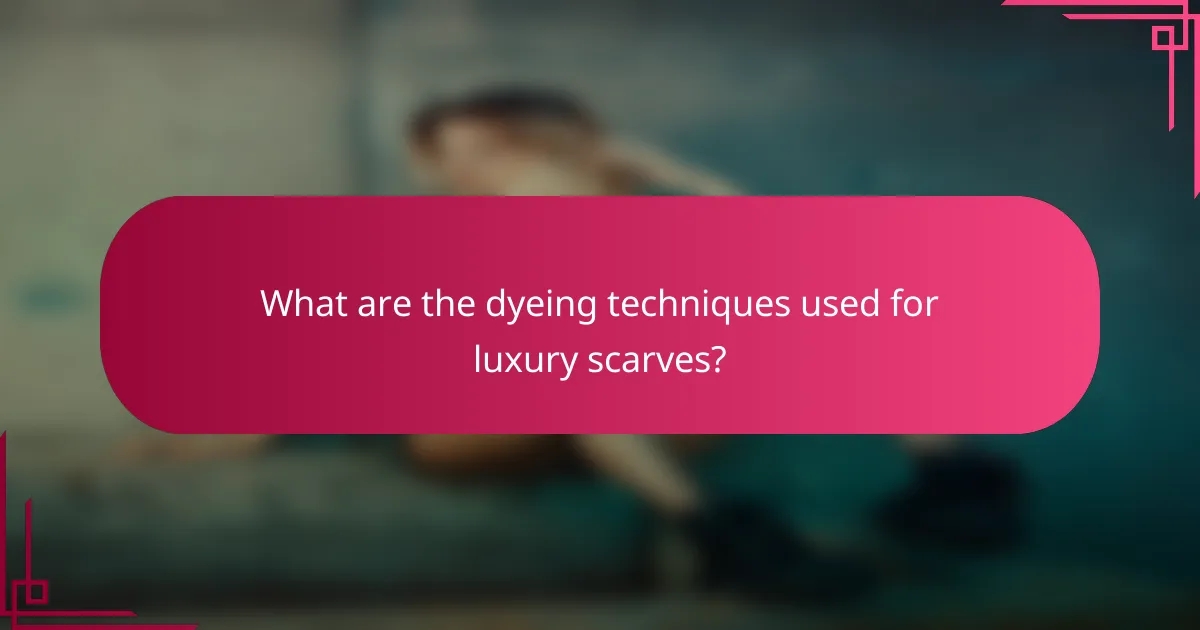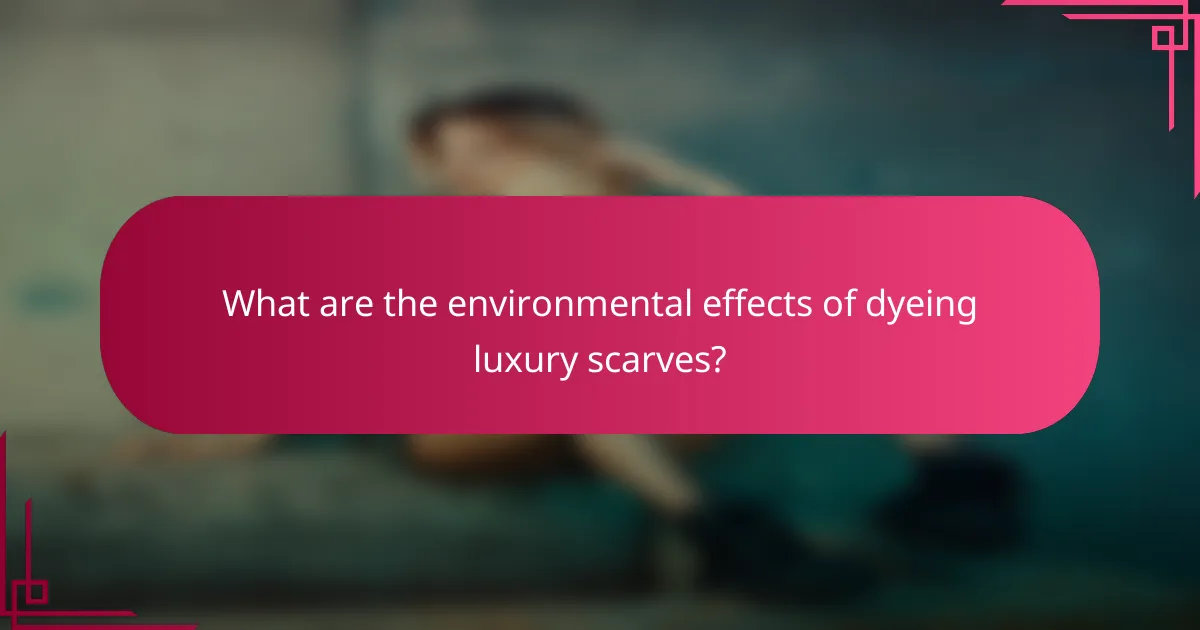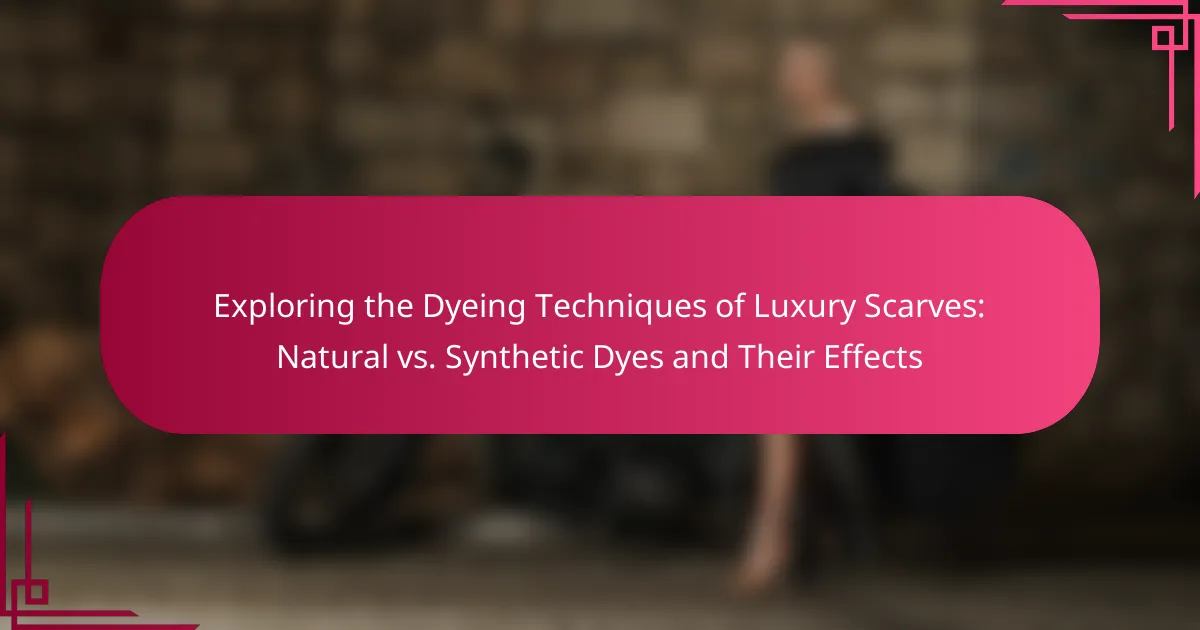The article explores the dyeing techniques used for luxury scarves, focusing on methods such as silk screen printing, tie-dye, and digital printing. Each technique employs either natural or synthetic dyes, which significantly impact the final appearance and environmental effects of the scarves. The discussion highlights the environmental challenges associated with dyeing processes, particularly the pollution caused by synthetic dyes and the potential harm to aquatic ecosystems. Additionally, the article provides care instructions for maintaining the quality and color of dyed luxury scarves, emphasizing proper washing and drying techniques to preserve their integrity.

What are the dyeing techniques used for luxury scarves?
The dyeing techniques used for luxury scarves include silk screen printing, tie-dye, and digital printing. Silk screen printing involves using stencils to apply dye onto fabric in layers. This technique allows for vibrant colors and intricate designs. Tie-dye is a method where fabric is tied or folded before dyeing, creating unique patterns. Digital printing uses inkjet technology to apply dye directly onto the fabric. This technique offers high precision and the ability to reproduce detailed images. Each technique can utilize either natural or synthetic dyes, impacting the final look and feel of the scarf.
How do natural dyes differ from synthetic dyes in luxury scarf production?
Natural dyes are derived from plant, animal, or mineral sources, while synthetic dyes are chemically manufactured. Natural dyes often provide a unique, rich color palette and are biodegradable. They can result in variations in color due to the natural materials used. Synthetic dyes offer a broader range of stable colors and consistency in production. However, synthetic dyes may contain harmful chemicals that can affect the environment. In luxury scarf production, artisans may prefer natural dyes for their organic appeal and sustainability. According to a study by the Textile Research Journal, natural dyes are gaining popularity for their environmental benefits and unique aesthetic qualities.
What are the common sources of natural dyes used for luxury scarves?
Common sources of natural dyes used for luxury scarves include plants, insects, and minerals. Plant sources often include indigo, madder, and turmeric. Indigo provides a deep blue color, while madder yields red hues. Turmeric is known for its vibrant yellow dye. Insect sources include cochineal, which produces shades of red. Minerals like ochre can provide earthy tones. These natural dyes are favored for their unique and rich colors. They also align with sustainable fashion practices.
What synthetic dyes are typically employed in luxury scarf manufacturing?
Luxury scarf manufacturing typically employs synthetic dyes such as azo dyes, reactive dyes, and disperse dyes. Azo dyes are widely used due to their vibrant colors and good lightfastness. Reactive dyes bond chemically with the fabric, ensuring durability and brightness. Disperse dyes are particularly effective for synthetic fibers like polyester, providing a wide color range. These synthetic dyes are favored for their ability to achieve consistent and vivid hues. They also offer advantages in terms of cost-effectiveness and ease of application in large-scale production.
Why is the choice of dye important for luxury scarves?
The choice of dye is crucial for luxury scarves because it affects color quality, fabric integrity, and sustainability. High-quality dyes enhance the vibrancy and longevity of colors. Natural dyes, for instance, provide rich hues and are often more environmentally friendly. Synthetic dyes can offer a wider color spectrum but may compromise fabric softness. The dyeing process also influences the scarf’s texture and feel. Moreover, luxury brands often prioritize ethical sourcing of dyes to appeal to conscious consumers. This attention to dye choice reflects the brand’s commitment to quality and sustainability.
How do dyes impact the colorfastness of luxury scarves?
Dyes significantly influence the colorfastness of luxury scarves. Colorfastness refers to a fabric’s ability to retain its color when exposed to various conditions. Natural dyes tend to have lower colorfastness compared to synthetic dyes. This is due to the chemical structure of natural dyes, which can be less stable. Synthetic dyes, however, are engineered for stability and often provide superior color retention. For instance, synthetic dyes can withstand washing and light exposure better than their natural counterparts. Studies have shown that scarves dyed with synthetic methods maintain their vibrancy longer. Therefore, the choice of dye directly affects the longevity and appearance of luxury scarves.
What role do dyes play in the overall aesthetic of luxury scarves?
Dyes play a crucial role in the overall aesthetic of luxury scarves. They determine the color vibrancy and richness of the fabric. High-quality dyes enhance the visual appeal and depth of patterns. Natural dyes often provide unique, organic hues that are highly sought after. Synthetic dyes can achieve brighter and more consistent colors. The choice of dye impacts the texture and feel of the scarf. Additionally, dye techniques influence the overall design and artistic expression of the piece. For example, hand-dyed scarves often showcase artisanal craftsmanship. This attention to dyeing contributes to the luxury status of the scarf.

What are the environmental effects of dyeing luxury scarves?
The environmental effects of dyeing luxury scarves are significant. Dyeing processes often involve toxic chemicals that can pollute water sources. Synthetic dyes, in particular, are known for their harmful environmental impact. They can release heavy metals and other pollutants into ecosystems. This contamination affects aquatic life and can disrupt local biodiversity. Additionally, the water used in dyeing can become contaminated, harming communities relying on these water sources. Natural dyes, while generally more eco-friendly, can still have environmental consequences depending on their sourcing and production methods. Overall, the dyeing of luxury scarves poses various environmental challenges that need addressing.
How do natural dyes affect the environment compared to synthetic dyes?
Natural dyes generally have a lower environmental impact compared to synthetic dyes. Natural dyes are derived from plants, minerals, and insects. They are biodegradable and less toxic. In contrast, synthetic dyes often contain harmful chemicals. These chemicals can pollute water sources during production and disposal. According to a study published in the Journal of Cleaner Production, synthetic dyeing processes can consume significant amounts of water and energy. This leads to greater carbon emissions. Additionally, synthetic dyes can cause severe ecological damage. Natural dyes, when sourced sustainably, can promote biodiversity. They also support local agriculture and economies.
What are the sustainable practices associated with natural dyeing?
Sustainable practices associated with natural dyeing include using renewable resources, minimizing water consumption, and reducing chemical usage. Natural dyes are derived from plants, minerals, and insects, which are biodegradable and less harmful to the environment. Farmers often grow dye plants in organic conditions, avoiding synthetic fertilizers and pesticides. This practice supports biodiversity and promotes soil health. Additionally, natural dyeing often employs traditional methods that require less energy compared to synthetic processes. Research shows that these methods can significantly lower carbon footprints. Overall, natural dyeing contributes to sustainable fashion by prioritizing eco-friendly materials and processes.
What environmental concerns are linked to synthetic dyeing processes?
Synthetic dyeing processes pose significant environmental concerns. These processes often involve toxic chemicals that can contaminate water sources. Wastewater from dyeing contains hazardous substances, including heavy metals and organic pollutants. When released untreated, this wastewater harms aquatic ecosystems. Additionally, synthetic dyes may contribute to soil degradation when improperly disposed of. The production of synthetic dyes also requires substantial energy, contributing to greenhouse gas emissions. Studies indicate that synthetic dye production can lead to increased carbon footprints in the textile industry. Overall, the environmental impact of synthetic dyeing is substantial and warrants attention.
Why should consumers consider the environmental impact of dyes?
Consumers should consider the environmental impact of dyes because they can significantly affect ecosystems. Many synthetic dyes contain harmful chemicals that pollute water sources. This pollution can lead to the destruction of aquatic life and biodiversity. Additionally, the production process of synthetic dyes often involves high energy consumption and toxic waste. According to a study by the United Nations, textile dyeing is responsible for 20% of global water pollution. Natural dyes, in contrast, generally have a lower environmental footprint. They are derived from renewable resources and are often biodegradable. By choosing dyes with less environmental impact, consumers can contribute to sustainability.
How can consumers make informed choices regarding dye types in luxury scarves?
Consumers can make informed choices regarding dye types in luxury scarves by understanding the differences between natural and synthetic dyes. Natural dyes are derived from plants, minerals, or insects and are often biodegradable. They are known for their rich colors and subtle variations. Synthetic dyes, on the other hand, are chemically manufactured and can produce vibrant and consistent colors.
Research indicates that natural dyes may be less harmful to the environment compared to synthetic options. A study by the American Chemical Society highlighted that synthetic dyes can contain toxic substances. Consumers should also consider the longevity and colorfastness of the dyes. Natural dyes may fade more quickly, while synthetic dyes typically offer greater durability.
It is essential for consumers to read labels and inquire about the dyeing process. Transparency from brands can help consumers understand the environmental impact and safety of the dyes used. By being aware of these factors, consumers can make choices that align with their values and preferences.

What are the care instructions for dyed luxury scarves?
Dyed luxury scarves require specific care to maintain their color and quality. Hand wash in cold water using a gentle detergent. Avoid wringing or twisting the fabric to prevent damage. Rinse thoroughly to remove all detergent. Lay flat to dry away from direct sunlight. Iron on a low setting if necessary, placing a cloth between the iron and the scarf. These instructions help preserve the integrity of the dyes and fabric.
How should luxury scarves dyed with natural dyes be cared for?
Luxury scarves dyed with natural dyes should be hand washed in cold water. Use a mild detergent specifically designed for delicate fabrics. Avoid using bleach or harsh chemicals, as they can damage the fibers and the dye. Gently agitate the water to clean the scarf without wringing or twisting it. Rinse thoroughly to remove all detergent. Lay the scarf flat on a clean towel to dry, avoiding direct sunlight to prevent fading. Store the scarf in a cool, dry place, preferably wrapped in acid-free tissue paper. Regular care helps maintain the vibrancy of natural dyes.
What specific washing techniques preserve natural dye integrity?
Gentle hand washing techniques preserve natural dye integrity. Use cool or lukewarm water to prevent color fading. Mild, pH-neutral detergents are recommended to avoid harsh chemicals. Avoid bleach or fabric softeners, as they can damage dyes. Rinse thoroughly to remove detergent without agitation. Air drying in the shade prevents sun exposure that can lead to fading. These methods are supported by textile preservation studies indicating reduced color loss.
How can one prevent fading in scarves dyed with natural dyes?
To prevent fading in scarves dyed with natural dyes, use a few effective techniques. First, wash the scarves in cold water. Cold water helps maintain color integrity. Second, avoid direct sunlight exposure when drying. Sunlight can significantly fade natural dyes. Third, use a mild detergent specifically designed for delicate fabrics. Harsh detergents can strip colors from the fabric. Fourth, store scarves in a cool, dark place. This prevents light-induced fading over time. Fifth, consider using a fixative after dyeing. Fixatives can help to set the dye and enhance color longevity. These methods are widely recommended by textile experts for preserving natural dye vibrancy.
What care tips apply to luxury scarves dyed with synthetic dyes?
Luxury scarves dyed with synthetic dyes require specific care to maintain their quality. Hand wash these scarves in cold water with a mild detergent. Avoid using bleach or fabric softeners, as they can damage the fibers. Gently squeeze out excess water without wringing or twisting the fabric. Lay the scarf flat on a clean, dry towel to air dry. Store the scarf in a cool, dry place away from direct sunlight to prevent fading. Regularly check for any signs of wear or damage to address issues promptly. Following these tips can prolong the life of luxury scarves dyed with synthetic dyes.
What are the recommended cleaning products for synthetic dye care?
The recommended cleaning products for synthetic dye care include gentle detergents specifically formulated for synthetic fabrics. Products such as Woolite or Tide Free & Gentle are effective in maintaining color vibrancy. These detergents are designed to be less harsh, reducing the risk of fading. Additionally, using a color-safe bleach can help remove stains without damaging the dye. It is important to avoid products with chlorine bleach, as they can cause discoloration. Always follow the manufacturer’s instructions for the best results.
What best practices can help maintain the quality of dyed luxury scarves?
To maintain the quality of dyed luxury scarves, proper care is essential. Hand washing in cold water is recommended to prevent color fading. Use a mild detergent specifically designed for delicate fabrics. Avoid wringing or twisting the scarf, as this can damage the fibers. Air drying is best; lay the scarf flat on a clean, dry towel. Store scarves in a cool, dry place away from direct sunlight to prevent discoloration. Regularly check for any signs of wear or damage to address issues early. Following these practices can significantly extend the life of luxury scarves while preserving their vibrant colors.
The main entity of this article is luxury scarves, specifically focusing on the dyeing techniques used in their production. The article explores various dyeing methods, including silk screen printing, tie-dye, and digital printing, while comparing natural and synthetic dyes in terms of their environmental impact, colorfastness, and aesthetic qualities. It highlights common sources of natural dyes and the advantages of sustainable practices, as well as care instructions for maintaining the quality of dyed scarves. Additionally, the article addresses the environmental concerns associated with synthetic dyeing processes, providing consumers with insights for making informed choices regarding dye types in luxury scarves.
